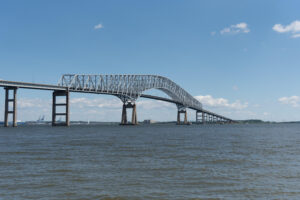ANALYSIS
Infrastructure safety: Learning from Baltimore
Kevin Barr on why the Baltimore bridge collapse should trigger a new approach to the safety and integrity of large infrastructure.
On March 26, a large cargo vessel collided with the Francis Scott Key Bridge in Baltimore causing it to collapse. The incident has left six men dead – all were construction workers fixing potholes on the bridge – and highlights urgent concerns about risk management, governance, and cultural attitudes towards infrastructure safety and modernisation.
Governance and modernisation lapses

The Francis Scott Key Bridge prior to the incident on March 26. CREDIT: Eric Ogden/Alamy
The bridge collapse serves as a stark reminder of the crucial need for stringent risk management practices in overseeing the safety and integrity of infrastructure. The inability to anticipate and mitigate the risks associated with such a collision, points to significant gaps in current risk management frameworks.
The sheer impact of the collision and the resulting catastrophic failure of the bridge indicate that existing safety measures and risk assessments were grossly inadequate. Engineering experts have noted that while bridges are designed to withstand impacts, the scale and nature of this incident were not within the anticipated range, suggesting a dire need for updated risk management strategies.
The imperative of enhanced risk management
This incident highlights a glaring oversight in the governance surrounding infrastructure modernisation. The 47-year-old Francis Scott Key Bridge, despite being a crucial component of Baltimore’s transportation network, lacked the necessary modern protective measures to prevent or mitigate such disasters.
The absence of dolphins or other modern defensive structures, which are standard in newer bridges to protect against ship collisions, points to a failure in governance and oversight. This oversight has had tragic consequences, emphasising the need for proactive measures and investments in modernisation.
Cultural challenges in infrastructure safety
Culturally, there appears to be a disconnect between the perceived safety of infrastructure and the reality of the risks involved. This tragedy suggests there is a critical need for a shift in how infrastructure maintenance and safety are viewed and prioritised. This incident should serve as a call to action, challenging cultural norms and prompting a more vigilant and proactive approach.
Only now when such a catastrophic incident has occurred have the concerns been raised as if there was always a problem with the bridge. It is too late and the cost too high to only consider effective risk management after the fact. This tragedy might never have happened if a culture around preventative risk management and design had been in place.
Catalyse a revaluation
This tragedy must catalyse a revaluation of our approach to infrastructure safety. Through rigorous risk assessment, robust governance, and a cultural recommitment to safety, we can honour the memory of those lost and safeguard the lives of countless others.
Infrastructure safety: Learning from Baltimore
Kevin Barr on why the Baltimore bridge collapse should trigger a new approach to the safety and integrity of large infrastructure.
Safety & Health Practitioner
SHP - Health and Safety News, Legislation, PPE, CPD and Resources Related Topics
Drug and alcohol testing in a UK airport environment
Investigation begins as bridge was “up to code”
Navigating turbulence: Boeing’s lessons in risk management


Nicely summed up – we need to beef up the protection to bridges worldwide especially those which are key to a region’s transportation network.